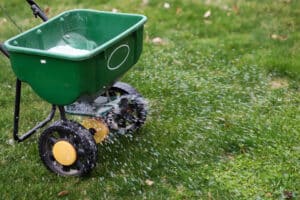Planting grass seed is a great way to achieve a fuller, greener lawn and create a lush outdoor space. However, timing is crucial—simply scattering seeds at random won’t guarantee success. To ensure proper germination and healthy growth, grass seeding must be done at the right time.
Spring is a popular season for yard work and landscaping projects, but knowing the right time for seeding is essential for the best results. In this guide, we’ll cover the key factors that affect seeding times, how to prepare your lawn for planting, and the best practices for maintaining strong, healthy grass year-round. We’ll also provide our recommendation for the best lawn care service to help you with this process.
Get a Quote From Lawn Professionals Near You
Compare quotes from local pros

Lime Soil Amendment

Lawn Fertilization
Factors That Influence Seeding Times
While many homeowners have a lawn care schedule in the spring, it’s not enough to just plant seeds at any point during the season. To ensure proper growth, you should consider your location as well as the type of grass you have, as these factors influence the right seeding conditions.
Location
Your location affects the type of grass you lay down and when it should be seeded. For example, many parts of the South use warm-season grasses to handle the temperate climate that prevails all year long.
Grass Type
Unsurprisingly, warm-season grasses thrive in warmer climates. These grasses, including turfgrasses, Bahia grass, Bermuda grass, zoysia grass, centipede grass, St. Augustine grass germinate in air temperatures above 80 degrees Fahrenheit.
If you live in an area of the country where temperatures stay fairly consistent year round, you can typically plant warm-season grasses from early spring to late fall. However, if your yard experiences the highs and lows of traditional seasons, be sure to plant your grass in late spring or early summer.
Cool-season grasses, including Kentucky bluegrass, tall fescue, fine fescue, and perennial ryegrass, fare better in areas of the country with temperate summers and chilly winters. This type of grass is dormant during the winter and grows during the fall and spring. It’s recommended that you plant your cool-season grass seed in late summer or early fall before temperatures dip below freezing. However, you can overseed with cool-season grass in the late spring or early summer with some care.
Weather
It’s important to keep an eye on weather conditions. For example, light rain may help seeds grow, though a heavy downpour could wash seeds away. Check the forecast to ensure a heavy storm isn’t approaching your area in the days after seeding.
In a similar vein, be sure to plant your seeds when the ground is sturdy and free of mud puddles, which can lead to disease. You’ll also want to avoid windy weather. Just as rain can wash seeds away, heavy winds can push newly-spread seeds across your existing lawn.
If perfecting this timing sounds overly complex, full-service lawn companies such as TruGreen lawn care can attend to seeding and fertilizing your lawn on the right schedule.
How to Prepare Your Lawn
While timing is important when seeding your lawn, preparation is also key. Preparing your lawn ensures that your soil is ready to promote new grass seed germination and growth. Preparing your yard consists of multiple steps, including actions like leveling your lawn, testing your soil, and aeration.



Level the Lawn
Before planting new seed, it’s important to remove any rocks and debris. Additionally, be sure to level the peaks and valleys in your yard with a soil mixture that consists of sand, topsoil, and compost. Don’t just use topsoil, as this fresh mixture may contain weed seeds and nutrients that can give rise to nuisance plants.
Test Your Soil
Much of a seed’s growth depends on the pH levels of your soil. Since every lawn’s pH is different, testing your soil is important to determine if it’s acidic, neutral, or basic. Based on these results, you’ll know which minerals and nutrients your soil is missing. Many home improvement stores, such as Lowe’s or Home Depot, sell simple five- or six-step DIY soil testing kits. If you prefer to use a professional, many full-service companies will do it for you.
Try Aeration
When your soil has become dense and compacted, it’s time to aerate your lawn. This loosens your tightly-packed soil and helps with weed control while allowing water and nutrients to reach grass roots. Try simple DIY methods like garden forks or aerator shoes for a lower cost of aeration. However, for more tightly compacted soil, you may want to contact lawn care professionals who have access to core aerator machines.
Address Bare Spots
Bare spots pop up in lawns for a variety of reasons, such as heavy foot traffic, drought, and insect infestations. Once you’ve identified the brown spots in your lawn, you can prepare them for overseeding by digging up the area, mixing in new topsoil, and using a rake to level the ground. From there, the bare spot is ready for seeding. To help prevent future bare patches, you can apply a pre-emergent herbicide, but don’t do so at the same time as you spread grass seeds or they won’t germinate.
Use Fertilizer
Fertilizing provides new lawns with concentrated nutrients needed to establish a strong root system. Cool-season grasses should be fertilized in the fall, while warm-season grasses can be fertilized throughout the summer. If you’re planting new grass seed, choose a starter fertilizer, which has a specific blend of nutrients to meet the needs of growing seeds until the root system develops.
Exactly When to Plant Grass Seed in the Spring
Planting grass seed at the right time in spring is crucial for optimal germination and growth. The best time varies by region due to differences in climate, soil conditions, and grass types. Below is a breakdown of the ideal spring seeding times for different areas of the United States.
Northeast
In the Northeast, the best time to plant grass seed is between mid-April and early May. Soil temperatures should be consistently above 50°F for cool-season grasses like Kentucky bluegrass and fescue to thrive. Avoid seeding too early when the soil is still cold or too late when summer heat sets in.
Southeast
For the Southeast, warm-season grasses like Bermuda, St. Augustine, and Zoysia should be planted between late March and mid-May. Soil temperatures should be around 65°F–70°F for optimal germination. Avoid planting too early, as frost can damage new seedlings.
Midwest
The ideal planting window in the Midwest is from mid-April to mid-May, depending on local temperatures. Cool-season grasses like ryegrass and fescue perform best when soil temperatures reach at least 50°F–55°F. Late spring seeding can be risky due to the hot summers common in this region.
Southwest
In the Southwest, warm-season grasses should be planted between late March and May when soil temperatures are around 65°F–75°F. Since this region experiences arid conditions, consistent watering is essential to help grass seed establish.
West Coast
For the West Coast, planting time depends on the local climate. In coastal regions with mild temperatures, seeding can start as early as February or March. Inland areas should aim for mid-March to May, depending on soil warmth and rainfall patterns.
Mountain West
In the Mountain West, cool-season grasses should be planted between late April and early June when the soil has thawed and temperatures stay above 50°F. Because of the high elevation and late frosts, waiting until the risk of freezing temperatures has passed is crucial for success.
By timing your grass seeding correctly for your region, you can ensure a lush, healthy lawn that thrives throughout the growing season.
Our Conclusion
Proper timing is crucial for successful grass seeding. If you have cool-season grass, aim to start seeding in late summer or early fall before freezing air and soil temperatures hit your area. For warm-season grasses, the best time to seed is in late spring or early summer when temperatures are consistently warm.
Regardless of the grass type, ongoing lawn care is essential after planting to support healthy growth. Regular watering, fertilization, and proper mowing will help establish a strong, resilient lawn. If maintaining your lawn sounds too time-intensive, consider hiring a professional lawn care service. TruGreen, for example, offers comprehensive seeding, fertilization, and maintenance services to keep your lawn looking its best year-round.
FAQ About When to Plant Grass Seed
Is March too early to plant grass seed?
March is too early to plant most grass seeds. Unless you live in a warm region, temperatures will be too low at this time of year. Be sure to wait until daily temperatures average around 80°F to plant warm-season grass and 50–65°F for cool-season grass.
Can you plant grass seed too early in the spring?
Yes, you can plant grass seed too early in the spring. Planting too early in the spring can cause poor germination, which harms the growing seeds. Wait for the air and soil temperature to warm up enough to plant your grass seed. Each grass is different, so check labels for specifics.
What month is best to put grass seed down?
The best month to put grass seed down depends on the type of grass you have and where you live. The best time to plant grass seed for cool-season grasses is in early fall or around September. For warm-season grasses, late spring or early summer (May to June) is the optimal time.
Can you plant grass seed in the fall to get it to grow in the spring?
You can plant grass seed in the fall to get it to grow in the spring through a process called dormant seeding. This type of seeding is done by putting down seed while the ground is not yet frozen but is still cold enough to prevent seed growth until the spring.

